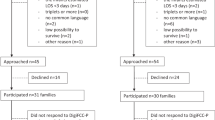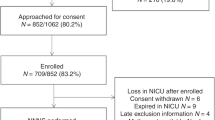Abstract
Objective:
To investigate the effects of parental presence and infant holding in the neonatal intensive care unit (NICU) on neurobehavior at term equivalent.
Study Design:
Prospective cohort enrolled 81 infants born ⩽30 weeks gestation. Nurses tracked parent visitation, holding and skin-to-skin care throughout the NICU hospitalization. At term, the NICU Network Neurobehavioral Scale was administered. Associations between visitation, holding and early neurobehavior were determined using linear and logistic regression.
Result:
The mean hours per week of parent visitation was 21.33±20.88 (median=13.90; interquartile range 10.10 to 23.60). Infants were held an average of 2.29±1.47 days per week (median=2.00; interquartile range 1.20 to 3.10). Over the hospital stay, visitation hours decreased (P=0.01), while holding frequencies increased (P<0.001). More visitation was associated with better quality of movement (P=0.02), less arousal (P=0.01), less excitability (P=0.03), more lethargy (P=0.01) and more hypotonia (P<0.01). More holding was associated with improved quality of movement (P<0.01), less stress (P<0.01), less arousal (P=0.04) and less excitability (P<0.01).
Conclusion:
Infants of caregivers who were visited and held more often in the NICU had differences in early neurobehavior by term equivalent, which supports the need for and importance of early parenting in the NICU.
This is a preview of subscription content, access via your institution
Access options
Subscribe to this journal
Receive 12 print issues and online access
$259.00 per year
only $21.58 per issue
Buy this article
- Purchase on Springer Link
- Instant access to full article PDF
Prices may be subject to local taxes which are calculated during checkout

Similar content being viewed by others
References
Anderson P, Doyle LW Victorian Infant Collaborative Study Group. Neurobehavioral outcomes of school-age children born extremely low birth weight or very preterm in the 1990s. J Am Med Assoc 2003; 289 (24): 3264–3272.
World Health Organization. Classification A, Surveys, Team T. ICIDH-2: International Classification of Functioning, Disability and Health: Final Draft, Full Version. Classification, Assessment, Surveys and Terminology Team. World Health Organization, 2001.
Lindberg B, Öhrling K . Experiences of having a prematurely born infant from the perspective of mothers in northern Sweden. Int J Circumpolar Health 2008; 67 (5).
Fanaroff AA, Kennell JH, Klaus MH . Follow-up of low birth weight infants: the predictive value of maternal visiting patterns. Pediatrics 1972; 49: 287–290.
Latva R, Lehtonen L, Salmelin R, Tamminen T . Visits by the family to the neonatal intensive care unit. Acta Pediatr (Stockholm) 2006; 96 (2): 215–220.
Franck LS, Spencer C . Parent visiting and participation in infant caregiving activities in a neonatal unit. Birth 2003; 30 (1): 31–35.
Reid M, Lloyd D, Campbell G, Murray K, Porter M . Scottish neonatal intensive care units; a study of staff and parental attitudes. Health Bull. (Melb.) 1995; 53 (5): 314.
Rosenfield AG . Visiting in the intensive care nursery. Child Dev. 1980; 51: 939–941.
Zeskind PS, Iacino R . Effects of maternal visitation to preterm infants in the Neonatal Intensive Care Unit. Child Dev 1984; 55: 1887–1893.
Latva R, Lehtonen L, Salmelin RK, Tamminen T . Visiting less than every day: a marker for later behavioral problems in Finnish preterm infants. Arch. Pediatr. Adolesc. Med. 2004; 158 (12): 1153.
Örtenstrand A, Westrup B, Broström EB, Sarman I, Åkerström S, Brune T et al. The Stockholm Neonatal Family Centered Care Study: effects on length of stay and infant morbidity. Pediatrics 2010; 125 (2): e278–e285.
Newnham C, Inder T, Milgrom J . Measuring preterm cumulative stressors within the NICU: the neonatal infant stressor scale. Early Hum Dev 2009; 85 (9): 549–555.
Lester BM, Tronick EZ, LaGasse L, Seifer R, Bauer CR, Shankaran S et al. The maternal lifestyle study: effects of substance exposure during pregnancy on neurodevelopmental outcome in 1-month-old infants. Pediatrics 2002; 110 (6): 1182–1192.
Cockburn F, Cooke R . The CRIB (Clinical Risk Index For Babies) score: a tool for assessing initial neonatal risk. Lancet 1993; 342 (8865): 193–198.
Barrington KJ . The adverse neuro-developmental effects of postnatal steroids in the preterm infant: a systematic review of RCTs. BMC Pediatr 2001; 1 (1): 1.
Franz AR, Pohlandt F, Bode H, Mihatsch WA, Sander S, Kron M et al. Intrauterine, early neonatal, and postdischarge growth and neurodevelopmental outcome at 5.4 years in extremely preterm infants after intensive neonatal nutritional support. Pediatrics 2009; 123 (1): e101–e109.
Miller SP, Ferriero DM, Leonard C, Piecuch R, Glidden DV, Partridge JC et al. Early brain injury in premature newborns detected with magnetic resonance imaging is associated with adverse early neurodevelopmental outcome. J Pediatr 2005; 147 (5): 609–616.
Gonya J, Nelin LD . Factors associated with maternal visitation and participation in skin-to-skin care in an all referral level IIIc NICU. Acta Paediatr (Stockholm) 2012.
Whitelaw A, Sleath K . Myth of the marsupial mother: home care of very low birth weight babies in Bogota, Colombia. Lancet 1985; 1 (8439): 1206.
Aucott S, Donohue PK, Atkins E, Allen MC . Neurodevelopmental care in the NICU. Mental Retard Dev Disabil Res 2002; 8 (4): 298–308.
Boukydis CFZ, Bigsby R, Lester BM . Clinical use of the neonatal intensive care unit network neurobehavioral scale. Pediatrics 2004; 113 (Supplement 2): 679–689.
Hoare BJ, Imms C . Upper-limb injections of botulinum toxin-A in children with cerebral palsy: a critical review of the literature and clinical implications for occupational therapists. The Am J of Occup Ther 2004; 58 (4): 389–397.
Johnson RE, Jones HE, Jasinski DR, Svikis DS, Haug NA, Jansson LM et al. Buprenorphine treatment of pregnant opioid-dependent women: maternal and neonatal outcomes. Drug Alcohol Depend 2001; 63 (1): 97–103.
Liu J, Bann C, Lester B, Tronick E, Das A, Lagasse L et al. Neonatal neurobehavior predicts medical and behavioral outcome. Pediatrics 2010; 125 (1): e90–e98.
Tronick EZ, Olson K, Rosenberg R, Bohne L, Lu J, Lester BM . Normative neurobehavioral performance of healthy infants on the neonatal intensive care unit network neurobehavioral scale. Pediatrics 2004; 113 (Supplement 2): 676–678.
Acknowledgements
This project was supported by the National Institute of Health (ROI HD 057098), the Doris Duke Charitable Foundation and the Washington University Intellectual and Developmental Disabilities Research Center.
Author information
Authors and Affiliations
Corresponding author
Ethics declarations
Competing interests
The authors declare no conflict of interest.
Rights and permissions
About this article
Cite this article
Reynolds, L., Duncan, M., Smith, G. et al. Parental presence and holding in the neonatal intensive care unit and associations with early neurobehavior. J Perinatol 33, 636–641 (2013). https://doi.org/10.1038/jp.2013.4
Received:
Revised:
Accepted:
Published:
Issue Date:
DOI: https://doi.org/10.1038/jp.2013.4
Keywords
This article is cited by
-
Unconditional cash transfers for preterm neonates: evidence, policy implications, and next steps for research
Maternal Health, Neonatology and Perinatology (2024)
-
Parent and grandparent neonatal intensive care unit visitation for preterm infants
Journal of Perinatology (2024)
-
NICU Couplet Care: metrics to guide an evolving model of care
Journal of Perinatology (2023)
-
Sensory-based interventions in the NICU: systematic review of effects on preterm brain development
Pediatric Research (2022)
-
Effectiveness of the Close Collaboration with Parents intervention on parent-infant closeness in NICU
BMC Pediatrics (2021)



